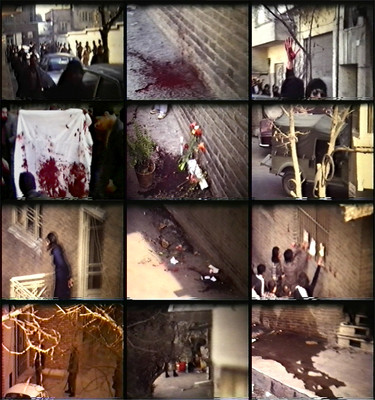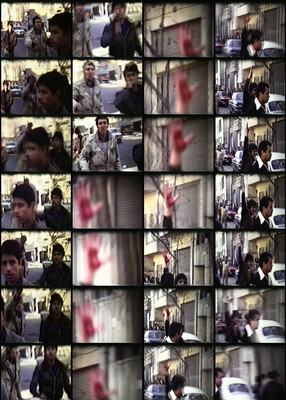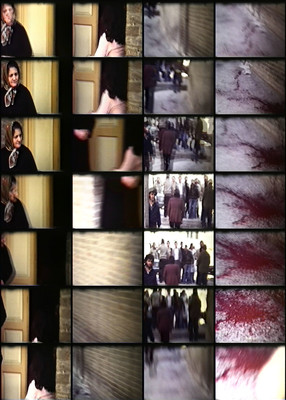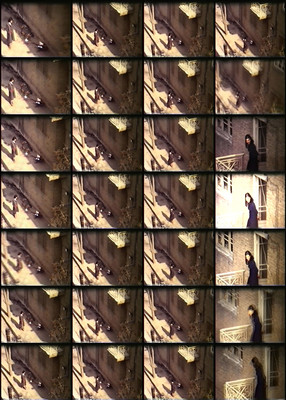Publication text
3 reels of 8mm silent film shot in a Tehran alley at the peak of the 1979 revolution*
Reel # 1: from a main road into a side street with a crowd running away / Then a sudden cut to a shaky, agitated close-up of a bloodstain on the sidewalk. People are now gathered around it, equally agitated / A hand covered in blood is raised, testifying to the bloodshed. The angry crowd is now raising their fists in the air. We do not hear their words / Cutting to a mark of a bloody palm on the wall / A white sheet being laid by two men over the bloodstain on the sidewalk, then removed, turned over and held up in front of the camera / The bloody sheet is carried up like a banner in the air by a now larger crowd, marching away from the alley.
Reel # 2: a hasty shot of a marching crowd / Then cutting back to the alley with the bloodstain, now covered with candles and flowers, a pot of greenery / Writings on pieces of paper are put on the wall. One reading: this is the evidence of Pahlavi’s crime / A cut to an army vehicle caught standing half visible on the corner of the alley / The camera cuts to a high angle view, presumably from a nearby balcony: all that was laid around the bloodstain has been scattered, the pot broken and the writings pulled off the wall / The alley is now abandoned except for a passer-by and the neighbouring woman looking down from the opposite balcony.
Reel # 3: back to the street level, neighbours picking up the scattered bits and pieces from around the bloodstain / A few people are putting up the writings and the flowers again / A crowd is slowly forming around the same spot / A sudden cut to a view from above: shaky, unfocused zoomed-in images of army men checking on and around the bloodstain / From a red bucket a solder is pouring water over the blood, sweeping the remains / The reel ends with a lower shot of the blood, now washed-away into the street drain.
...
Does it really matter that these three reels of 8mm film ever existed? Or even what took place on that sunny winter day of the revolution, in that particular street in Tehran? Does it really make a difference that some of it was shot on film, or even the fact that you can look at them today?
If these three reels of film had never been exposed to what took place in that alley, the event would never have taken place on film and consequently they would never have existed before your eyes.
The reverse of this pseudo-fatalist scheme should also be accounted for, that is, if the event had not taken place, the three reels of film would most probably have not been exposed to light that day, so that you can watch them today.
The difference that the existence of these reels, the event they depict, and now you watching them make is precisely the overlapping of a flashback and its reverse into the future.
There are in fact two angles from which you can view this footage of the revolution: as a record of a past event, or of an undefined future. In fact the two are not divisible without a remainder, and that remainder is the three reels of 8mm film. History is maybe this remainder suspended between a past and an undefined future, always coinciding with the time we are in.
...
Let us imagine you shot these three reels of film, that you held the camera in your hand and looked through the viewer to what took place that day. Let us imagine that in 1979, the year of the revolution, you were in that alley in Tehran.
Now try to remember what happened. Not what is shot on these three reels of film, but what actually took place before your eyes. Try to remember the moments between each shot, the space of the cuts, the cuts you were forced to bring into the continuity of the event by releasing the shutter repeatedly, out of fear for you life. Try to relive the time when the viewer of the camera was not in front of your eyes. Now suddenly what is on film is not as it actually happened there…
Cameramen in conflict zones often only remember what took place in front of their lens. This may be a way of warding off the horror of the real memory of what they witnessed with their own bare eyes. What they “remember” stems from what they have seen on film after the shooting.
The question is if there is a remainder from the moments between each shot on these three reels of film. Certainly the cuts themselves are primary indicators of those moments, of a temporal space that was not caught on film. But to be able to see beyond the cuts, to get closer to what actually took place when the camera was not running, one has to look beyond the depicted event, to pull closer to the surface of the film footage, to look at the “affects” in the shooting itself.
Looking at this footage, we are in fact witnessing the course of two events: what is taking place in front of the camera, and the act of the shooting itself. We are dealing with two layers of intensities. The first is a clash between the revolutionary symbolization of the bloodstain by the people, i.e. by reproducing it into a banner, and the prevention of this symbolization by the army pouring water over it.
And the second layer being the hazy cuts, shaky zoom-ins and the blurry images, and sudden changes of the angle in the shooting. These almost fierce – hazy, shaky, sudden, and blurry – effects are of the flow of a different event than what is documented. They mark the film’s emulsion and with it your field of view of the depicted event. You try to look pass them in order to forget, but they are always there, lurking. What was left out during the shooting by releasing the shutter still found its way onto the film. How are we to read these marks other than as remainders of an absence, of absent scenes that were never shot?
And this brings us to the real subject of this footage, who is actually absent from all three reels, and from whom we only see the bloodstains around which the event in that alley evolves… Again, on these three reels of film we follow and experience two ways of tackling the materiality of the stain. One is its suppression through its absorption into the revolutionary symbolism, and the other through its mutation into other staining and indecisive affects, of which the juddering shooting is the result. It is as though the bloodstain has left its residue on the film’s emulsion.
And it is the mediation of absence on these three reels that enables them to escape historical interpretation. Once mediated it is impossible to fill in the absence by any-thing or any-body. Unlike televised images of the revolution that are instituted by discourses of certainty – whether broadcasted during, immediately after, or in the following years since the revolution – this raw footage is conditioned by what takes place in the alley. The images on these three reels of film are themselves structurally and substantially affected by the event synchronous to its depiction. Their extreme immediacy to the event, on the level of each cut, zoom-in and out, change in angle, haziness, and pace, makes their production into historical pretexts for discourses of power simply impossible. Moreover, with their very representational undecidability, the images are simply too unripe to be dated. These are un-produced images of revolution, and they should be re-penetrated into historicised representations of the present. As such they introduce a representational disjuncture into the basis of history and power relations. We must let the absent return from the discarded past, to haunt us not as dead, but as always coming to bring us other histories.
footnote:
* Absent Subject of the Revolution is the first of a series of Pages’ editorial projects attempting to re-address those minor histories that were recorded – with immediacy to their unfolding – on film, video, sound, or any other medium.
The recordings addressed in this project were shot on three reels of 8mm film by the film maker Kamran Shirdel and are of an event that took place at the peak of Iran’s 1979 revolution in an alley in Tehran where he lived.
Absent Subject of Revolution was first presented at the exhibition Interrupted Histories, Moderna Gallerija, Ljubljana, March 2006.
Image credit: Film stills from video copy of super 8 reels shot by Kamran Shirdel.



